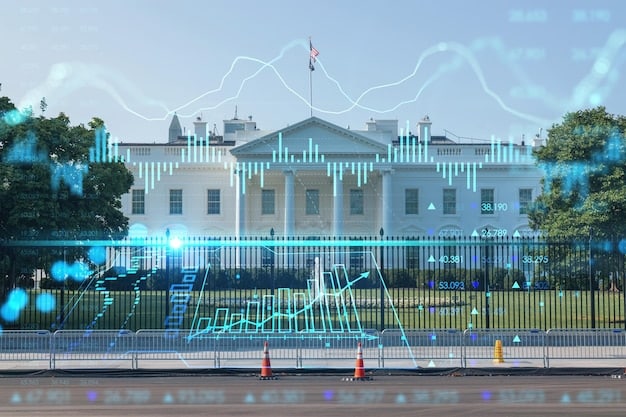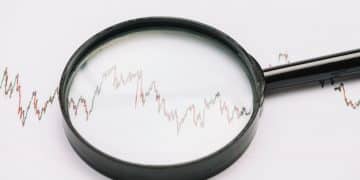The 2025 Economic Report: Key Findings & Policy Impact

The 2025 Economic Report of the President analyzes the U.S. economy’s performance, key trends, and provides policy recommendations for sustainable growth, addressing challenges like inflation, labor market dynamics, and global economic uncertainties.
The 2025 Economic Report of the President: Key Findings and Policy Recommendations is a crucial document that provides a comprehensive overview of the U.S. economy, offering insights into its performance, challenges, and future prospects. This report serves as a guide for policymakers, economists, and the general public, outlining the administration’s economic agenda and priorities.
Understanding the Core of the Economic Report
The Economic Report of the President is an annual publication that offers a detailed analysis of the U.S. economy. It covers a wide range of topics, including economic growth, employment, inflation, and international trade. Understanding the core components of this report is essential for anyone seeking to grasp the current state and future direction of the American economy.
Key Indicators and Their Significance
Several key economic indicators are highlighted in the report, each providing a snapshot of different facets of the economy. GDP growth, unemployment rates, and inflation are among the most closely watched.
Policy Recommendations Overview
The report also outlines the administration’s policy recommendations aimed at addressing economic challenges and fostering sustainable growth. These recommendations often span fiscal, monetary, and regulatory policies.
- GDP Growth: Measures the rate at which the economy is expanding. A higher growth rate typically indicates a healthier economy.
- Unemployment Rate: Indicates the percentage of the labor force that is unemployed. Lower rates suggest a stronger job market.
- Inflation: Reflects the rate at which prices for goods and services are rising. Moderate inflation is generally considered healthy, but high inflation can erode purchasing power.
- Trade Balance: Represents the difference between a country’s exports and imports. A trade surplus indicates that a country exports more than it imports.
In essence, the Economic Report of the President serves as a roadmap for understanding the complex interplay of economic forces and the policy decisions designed to shape them. By examining these core elements, stakeholders can gain valuable insights into the health and trajectory of the U.S. economy.
Analyzing Economic Growth in 2025
Economic growth is a fundamental indicator of a nation’s prosperity. The 2025 Economic Report provides a detailed analysis of the factors driving economic growth and the challenges that could potentially hinder it. Understanding these dynamics is crucial for assessing the overall health of the U.S. economy.
Factors Contributing to Growth
Several factors can contribute to economic growth, including technological innovation, increased productivity, and government policies that stimulate investment and job creation.
Potential Obstacles to Growth
Conversely, factors such as inflation, rising interest rates, and global economic uncertainties can impede economic growth. The report assesses these potential obstacles and proposes strategies to mitigate their impact.

Ultimately, the analysis of economic growth in the 2025 Economic Report is a critical component for understanding the broader economic landscape and informing policy decisions aimed at sustaining long-term prosperity.
The Labor Market: Trends and Challenges
The labor market is a vital component of the U.S. economy, and the 2025 Economic Report offers a thorough examination of its trends and challenges. Understanding these dynamics is crucial for policymakers and businesses alike, as they navigate the evolving landscape of employment and workforce development.
Employment Rates and Demographics
The report analyzes employment rates across different demographic groups, providing insights into potential disparities and areas where targeted interventions may be necessary.
Skills Gap and Workforce Development
One of the key challenges facing the labor market is the skills gap, where employers struggle to find workers with the necessary skills to fill open positions. The report addresses this issue and recommends strategies for workforce development and training programs.
- Automation: The increasing automation of jobs poses both opportunities and challenges for the labor market.
- Gig Economy: The rise of the gig economy has created new forms of employment but also raises questions about worker protections and benefits.
- Remote Work: The shift towards remote work has transformed the way many companies operate and has implications for labor force participation and productivity.
- Skills Training: Investing in skills training and education is essential for equipping workers with the tools they need to succeed in the modern economy.
By addressing these trends and challenges, policymakers and businesses can work together to create a more resilient and inclusive labor market that benefits all Americans.
Inflation and Monetary Policy Responses
Inflation is a persistent economic concern that can erode purchasing power and destabilize financial markets. The 2025 Economic Report addresses the causes of inflation and the monetary policy responses aimed at keeping it in check. Understanding these dynamics is crucial for maintaining economic stability.
Causes of Inflation
The report identifies factors such as supply chain disruptions, increased consumer demand, and rising energy prices as potential drivers of inflation.
Federal Reserve’s Monetary Policy Tools
The Federal Reserve plays a central role in managing inflation through its monetary policy tools, including adjusting interest rates and managing the money supply.

Effective monetary policy is essential for maintaining price stability and ensuring the long-term health of the U.S. economy.
Fiscal Policy and Government Spending
Fiscal policy, which involves government spending and taxation, plays a significant role in shaping the U.S. economy. The 2025 Economic Report examines the impact of fiscal policy decisions on economic growth, employment, and income inequality. Understanding these effects is crucial for informed policy debates.
Government Spending Priorities
The report outlines the administration’s spending priorities, including investments in infrastructure, education, and healthcare. These investments are aimed at boosting economic growth and improving the quality of life for Americans.
Tax Policy and Revenue Generation
Tax policy is another important component of fiscal policy, with implications for revenue generation and income distribution. The report analyzes the impact of current tax policies and considers potential reforms.
In conclusion, fiscal policy is a powerful tool for shaping the U.S. economy, and the 2025 Economic Report provides a comprehensive analysis of its effects and potential reforms.
International Trade and Global Economic Trends
International trade is an increasingly important aspect of the U.S. economy, and the 2025 Economic Report offers an overview of global economic trends and their impact on American businesses and consumers. Understanding these dynamics is essential for navigating the complexities of the global marketplace.
Trade Agreements and Their Impact
The report analyzes the impact of trade agreements on U.S. exports and imports, as well as their broader effects on the economy.
Global Economic Uncertainties
Global economic uncertainties, such as geopolitical tensions and currency fluctuations, can also impact international trade. The report assesses these risks and proposes strategies for mitigating their effects.
- Supply Chains: The resilience and diversification of global supply chains are critical for ensuring a stable flow of goods and services.
- Trade Wars: Trade disputes and protectionist measures can disrupt international trade and harm economic growth.
- Emerging Markets: Emerging markets offer significant opportunities for U.S. businesses but also present unique challenges.
By addressing these issues, policymakers and businesses can work together to promote fair and sustainable international trade that benefits all Americans.
| Key Point | Brief Description |
|---|---|
| 📈 Economic Growth | Analysis of factors driving growth and potential obstacles. |
| 💼 Labor Market | Examination of employment rates, skills gap, and workforce development. |
| 💰 Inflation | Discussion of causes and monetary policy responses. |
| 🌍 International Trade | Overview of global trends, trade agreements, and economic uncertainties. |
Frequently Asked Questions
▼
The Economic Report of the President is an annual report that provides a comprehensive overview of the U.S. economy, including analysis of key trends and policy recommendations.
▼
The Council of Economic Advisers (CEA) prepares the Economic Report of the President. The CEA is a team of economists who advise the President on economic policy.
▼
The report covers a wide range of topics, including economic growth, employment, inflation, fiscal policy, monetary policy, and international trade, among others.
▼
The report provides valuable insights to policymakers, helping them make informed decisions about economic policy based on thorough analysis and data-driven recommendations.
▼
The full Economic Report of the President is available on the website of the Government Publishing Office (GPO) and other government websites, often as a PDF document.
Conclusion
In conclusion, The 2025 Economic Report of the President: Key Findings and Policy Recommendations provides essential insights into the U.S. economy’s performance and outlines policy recommendations to foster sustainable growth and address key challenges. By analyzing economic indicators, labor market trends, inflation, fiscal policy, and international trade, the report offers a comprehensive roadmap for policymakers, economists, and the public to understand the economic landscape and make informed decisions.





